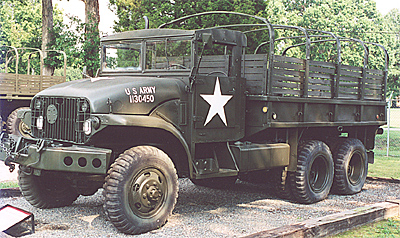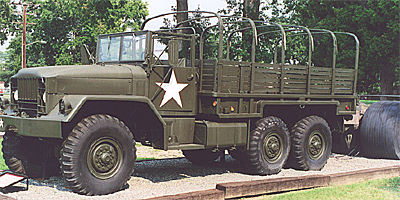 Cargo Handling Yard
Cargo Handling Yard
Trucks: A Short History
The Army truck has become the most flexible mode of logistical support in the 20th century. General Patton called Army trucks the most valuable weapons of World War II.
In the 1800s, a four-mule wagon could haul a 1,000-lb load about 20 miles. At day's end, the animals had to be unhitched, rubbed down and fed. By 1914, trucks were considerably more cost effective, carrying four or five 1,000 lb loads per day, much farther. They were also easier to repair and replace.
Testing of trucks and automobiles began in the early 1900s. Little standardization was required initially, and when Pershing called for motor transport for the Punitive Expedition into Mexico in 1916, the Army had to scramble for whatever was available, and consequently, experienced incredible maintenance problems.
In WW I, the "Liberty Truck" was designed as a standardized vehicle. Powered by a 425 cubicinch, 4-cylinder engine mustering up to 52 hp, it rode on solid rubber tires and hauled a load of 3 tons.
Three highly significant vehicles serviced the Transportation Corps in WW II. First was the CCKW was a 2-1/2 ton 6x6, noted for its ability to haul almost anything. Second was the DUKW, a 2-1/2 ton truck with welded hull developed to serve as a motorized lighter. It carried cargo from ships directly to the shore. In its baptism of fire during the invasion of Sicily, the DUKW handled 90% of all cargo in the second and third days of the operation.
The third was perhaps the most famous vehicle - the Jeep. This 4x4 light truck became a utility vehicle, a command vehicle and a reconnaissance vehicle because of its incredible versatility and cross-county performance. The Jeep is best characterized by cartoonist Bill Mauldin who refused to use the word 'road' in the presence of his Jeep because "it had never been on one."
In the 1980s, the HMMWV (High Mobility Multi-Purpose Wheeled Vehicle) was developed as a successor to the Jeep. With an automatic transmission and V-8 engine, the HMMWV drives its 2-ton plus curb weight over terrain that by sight would be considered inaccessible. Used extensively in the Gulf War, the Hummer (displayed in the Desert Storm exhibit) can be deployed in various configurations, from personnel or cargo carrier to armored vehicle.
Most of our trucks are displayed in the Cargo Yard, but some are under cover near the Rail Yard. Those in the cargo yard are listed first in counter-clockwise order from the gate.
TRUCK TRACTOR, 5-TON, 4x2 Manufactured by International Harvester, this Fleetstar 200 tractor was used by the 37th Trans Group in Germany in the 1960s and 1970s. One of several commercial trucks, it pulled a variety of trailers and was used in over-the-road operations in place of tactical vehicles.
SEMI-TRAILER, M-129A1 This van-type semi-trailer was designed to be towed by the 5-ton M-52 tractor and carried 12 tons. Weighing 16,020 lbs, it was 28' 2" long, 7' 4" wide and 6' 6" high. Van trailers like this were used as supply storage areas in the 1960s.
XM211 CARGO TRUCK , 2 1/2 ton, 6x6 Developed after WW II by General Motors, this M-series 6x6 cargo vehicle replaced the CCKW, with an extended mechanical life and better roadworthiness. Operated in all climates and weather conditions, this vehicle's off-road performance was improved with an automatic transmission. It has the conventional removable canvas top and cargo area with removable wooden sides, bows and tarp cover. A winch can be mounted on front, as can deep fording kits and winterization kits. They are no longer in use by the Army.
 CARGO TRUCK, M41, 5-TON, 6x6 Manufactured by International Harvester, this was the standard 5-ton, 6x6 cargo truck for the US Army in the 1950s to 1960s for moving men and equipment. Used heavily in Korea, this truck was powered by a Continental R-6602, 6cylinder OHV engine, and used over all types of roads. Because of the single rather than duel rear wheels, it provided much better off-road traction for cross-country terrain. It was replaced by the M-54, which utilized the same basic chassis.
CARGO TRUCK, M41, 5-TON, 6x6 Manufactured by International Harvester, this was the standard 5-ton, 6x6 cargo truck for the US Army in the 1950s to 1960s for moving men and equipment. Used heavily in Korea, this truck was powered by a Continental R-6602, 6cylinder OHV engine, and used over all types of roads. Because of the single rather than duel rear wheels, it provided much better off-road traction for cross-country terrain. It was replaced by the M-54, which utilized the same basic chassis.
FORKLIFT, 6000-LB This Atley built forklift was a standard piece of material handling equipment developed after the standardization of cargo loads, like the CONEX and the pallet.
ROUGH TERRAIN TRACTOR, M-52,5-TON, 6x6 Used in Vietnam in the 1960s, this tractor was last used in Operation Desert Storm by the 68th Transportation Battalion. Made to ford hardbottom rivers as deep as 30 inches, it has a maximum speed of 52 mph and averages 5 mpg, with a cruising range of 550 miles. It can tow 30,000 lbs on highway or 30,000 lbs crosscountry in 6-wheel drive.
TRAILER, M-127A1, 30-FT This general cargo semi-trailer was towed by the 5-ton M-52 truck tractor. A 12-ton 4wheeled stake type trailer, it is 22' long, 7' 5" wide and 4' high, weighting 14,400 lbs. The 419th Transportation Battalion used it in Operation Desert Storm.
CARGO TRUCK, LMTV, XM-1078 In 1985, the Army introduced this Light Medium Tactical Vehicle (LMTV). It can be air transported in the USAF C-130, lifted by helicopter, and can be dropped with the low altitude parachute extraction system (LAPES). Manufactured by Stewart and Stevenson, this 2 1/2 ton truck replaces the current M-44 series of trucks. Powered by a 225hp Caterpillar 3116 diesel engine, it has a fully automatic 7-speed Allison transmission that is electronically controlled (push button), and full-time all-wheel drive. The driver controls the central tire inflation system from inside the cab. The cargo bed is all steel with drop-sided rail storage, and can be fitted with stowable non-wooden troop seats or a bow-and-tarp kit. Other options include an electric loading/unloading crane, and a hydraulic self-recovery winch. It can also tow a light vehicle trailer (LMTVT).
To be moved from the Rail Yard to the Cargo Yard:
Says the brochure:
TRUCK, CARGO, 16-TON, 4x4, XM437E1 GOER
Designed for cross-country mobility, the Goer was tested in 1960 in the desert and sub-zero weather, and for amphibious operations. Nineteen Goers were sent to Vietnam in June 1966, and for their first 18 months, moved more than 20 million pounds of cargo, plus nearly 1.7 million gallons of fuel, more than 158,000 miles. Powered by a General Motors diesel 8-cylinder, 2-cycle engine, the maximum speed was 31 mph. The tires are 16-ply large diameter, low pressure, and high flotation, with central inflation and deflation controllable from the cab. The vehicle is floatable with a load, its water speed about 3 mph using the front wheels for propulsion. This particular Goer was tested at Fort Eustis in the early 1960s.
More Fort Eustus US Army Transportation Museum
- Introduction
Museum Building
Railroad Park
Cargo Handling Yard
Aviation Pavilion
Marine Park
Summary
Back to List of Historic Sites
Back to Travel Master List
Back to MagWeb Master List of Magazines
© Copyright 2003 by Coalition Web, Inc.
This article appears in MagWeb (Magazine Web) on the Internet World Wide Web.
Other articles covering military history and related topics are available at http://www.magweb.com